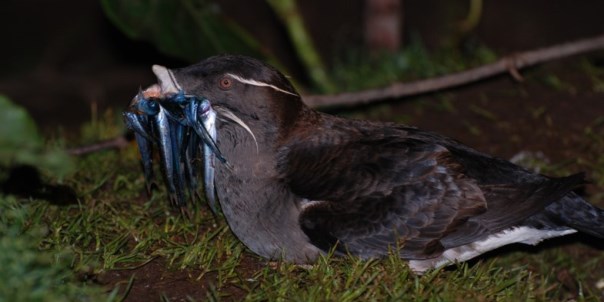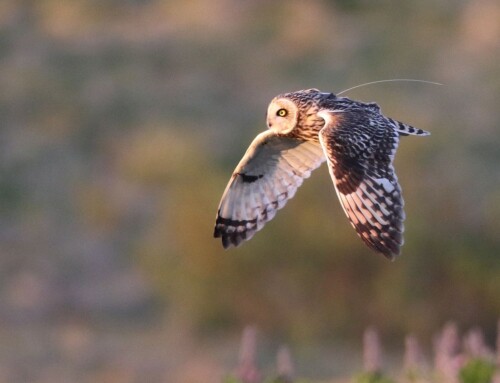Auklet mates synchronize their activity after independent migration
LINKED PAPER
Rhinoceros Auklet pair-mates migrate independently but synchronize their foraging activity during the pre-laying period. Kubo, A., Takahashi, A., Thiebot, J.B., Watanuki, Y. 2018. IBIS. DOI: 10.1111/ibi.12583. VIEW
I am sure that many among you have already felt this: When you are on the field, recovering loggers that were deployed on birds a year ago: relieved at first (the surveyed bird is back), then you immediately feel impatient to have a look at the data logged throughout the elapsed year. What did the bird do in-between two breeding seasons? Where did it go? No matter how many birds you have recaptured on that day or during your life: with every single recapture, the same excitement comes up for sure.
And what is even more exciting is to recapture two surveyed birds from the same nest. Two partners, which had both been equipped with loggers one year ago, raised a chick successfully, and flapped goodbye to each other in the late summer. Until they came back to the same nest, and start catching up with their good old mate, for a new season together again.
This seems common indeed in migratory seabirds: outside the breeding season, they show no need to remain with their partner anymore. Yet, it brings more questions than answers. We know that maintaining pair bonds is often important for breeding successfully in long-lived birds. But how do they maintain this intimate relationship needed for mating, while they may migrate hundreds of kilometres apart, at sea?
It took some years to recover enough loggers attached to paired birds over successive breeding seasons, in order to make a decent contribution to this question.
In our paper published in IBIS, we show migration paths of Rhinoceros Auklet, Cerorhinca monocerata, mates tracked from Teuri Island (Japan). These data indicate that within each pair, the two partners migrated independently (Fig. 1). Not that they used totally gender-exclusive separated areas, but they had slightly different timings across the successive steps of their migration: this shift put them 377 km apart an average (similar values were obtained for re-combined “pairs” of non-mates). As a consequence, the two mates likely did not meet at sea in-between two breeding seasons, they do not return to the colony at the same date (5.6 days difference, on average; either the male or the female could be the first to come back).

The results are striking. Our saltwater-immersion loggers showed that as soon as both birds have returned and spent the first night together at the colony, they exhibited a clear synchronization of their on-water/in-air activities at sea (Figs 2 and 3). The synchronization of their respective activities was actually highest on the day following the nights when both mates visited the colony, and then decreased over time. It is thus very clear that after their migration, mates enter in a phase of re-coordination, linked to their nights spent together at the colony; this phase probably allows them to engage in a breeding activity successfully.
Later on, when both mates leave the colony together for the pre-laying exodus at sea, we observed the same phenomenon: they kept synchronizing their at-sea activity, at least during the early part of this period.


Our interpretation of this remarkable behaviour is that mates were staying together at sea during the pre-laying period: this likely explains how they could synchronize so well their activities after their first re-meeting at the nest. The male may actually be actively guarding the female at sea to prevent extra-pair copulation (which happens indeed, in alcids). Facing a risk of extra-pair fertilization, males would accordingly increase their chances of effective copulation by staying close to the females, from their first re-meeting, and nearly until the female lays the egg.
Besides, many seabirds choose to breed at the same nest site, over successive seasons. We believe that this behaviour may further facilitate the re-mating process in these species, as our study shows that the two partners do not migrate together and do not synchronize their arrival at the colony. And we must admit that this fidelity to the partner and to the nest site also greatly facilitates recovering the data-loggers, from year to the next.
References
Kubo, A., Takahashi, A., Thiebot, J.B., Watanuki, Y. 2018. Rhinoceros Auklet pair-mates migrate independently but synchronize their foraging activity during the pre-laying period. IBIS. DOI:10.1111/ibi.12583. VIEW
Image credit
Featured image: Rhinoceros Auklet, Cerorhinca monocerata, on Teuri Island, Japan © Motohiro Ito
Blog posts express the views of the individual author(s) and not those of the BOU.
If you want to write about your research in #theBOUblog, then please see here.





